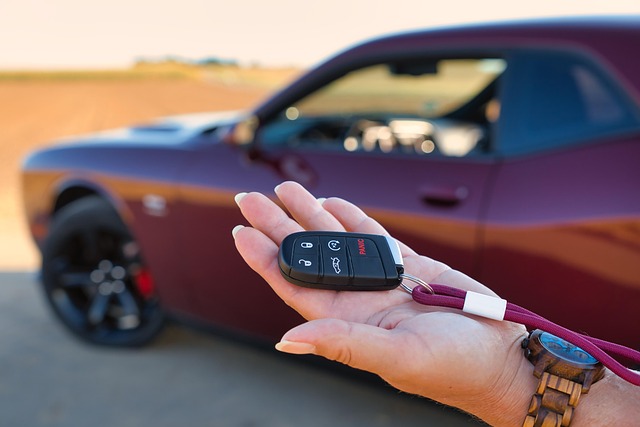Registering a car in California involves understanding specific requirements and gathering essential documents. This comprehensive guide walks you through each step, from confirming your vehicle’s VIN (a crucial aspect of the process) to visiting the DMV and finalizing registration. We’ll outline the necessary paperwork, streamline the verification process, and ensure you have a smooth experience. By following these steps, including the critical vin verification, you’ll be on your way to legal California car registration in no time.
- Understand California Vehicle Registration Requirements
- Gather Necessary Documents for Car Registration
- Perform VIN Verification: Steps and Importance
- Visit Your Local DMV: The Registration Process
- Finalize and Obtain Your California Registration Papers
Understand California Vehicle Registration Requirements

Before registering your car in California, it’s crucial to understand the state’s vehicle registration requirements. These include ensuring that your vehicle meets safety and emission standards, providing proof of insurance, and having a valid and accurate Vehicle Identification Number (VIN) verification. The VIN is a unique code that identifies your vehicle and is essential for official records. In California, this process often involves obtaining a Certificate of Compliance from the manufacturer or an authorized dealer, confirming that your car adheres to state safety regulations.
Additionally, you’ll need to complete a mobile VIN verification, which allows you to check your vehicle’s history remotely. This can be done through various online services or even some mobile apps. A mobile vin inspection ensures that your car has no outstanding issues, such as theft, flood damage, or unpaid fines, which could hinder the registration process. By taking care of these requirements early on, you’ll streamline the registration process and avoid potential delays or complications.
Gather Necessary Documents for Car Registration

Before you begin the registration process for your car in California, it’s crucial to gather all the essential documents. One critical step is to verify and provide the Vehicle Identification Number (VIN) details. This includes a valid VIN inspection or verification, ensuring the accuracy of the vehicle’s information. You can conduct this process through various methods, including a mobile vin inspection, making it convenient for California residents.
The required documents typically include proof of ownership, such as a title certificate, a current registration, and valid identification like a driver’s license. Additionally, you’ll need to present evidence of insurance and, in some cases, pay relevant fees. A complete checklist is available from the California Department of Motor Vehicles (DMV) to ensure you have everything needed for a smooth car registration process.
Perform VIN Verification: Steps and Importance

Performing a Vehicle Identification Number (VIN) verification is a crucial step in the car registration process in California. It’s an essential check that ensures the vehicle’s history and authenticity, protecting both buyers and sellers from potential fraud. The process involves using a trusted mobile VIN verifier or performing a simple online check to compare the provided VIN with records maintained by various state and federal agencies.
This verification ensures the vehicle isn’t stolen, has no outstanding recalls, and matches the make, model, and year listed on the registration documents. Many mobile VIN inspection apps offer quick and convenient services, allowing you to complete this task from the comfort of your home or even before visiting the DMV. By ensuring a clean VIN report, you’re one step closer to smoothly registering your vehicle in California.
Visit Your Local DMV: The Registration Process

To begin the car registration process in California, start by visiting your local Department of Motor Vehicles (DMV) office. Bring all necessary documents, including your vehicle’s title, valid driver’s license, proof of insurance, and identification showing your current address. The DMV will guide you through the steps, which typically involve a vin verification to ensure the vehicle’s authenticity.
During this process, you can expect to fill out registration forms, pay associated fees, and possibly undergo a vin inspection. A mobile vin verifier or inspector might be available if needed, offering convenience for those who prefer not to visit the DMV in person. This streamlined approach ensures your car is legally registered and ready for California’s roads.
Finalize and Obtain Your California Registration Papers

After ensuring all necessary documents are ready, it’s time to finalize and obtain your California registration papers. This crucial step involves verifying your vehicle’s unique identifier, known as the Vehicle Identification Number (VIN). You can complete this process using a mobile VIN verifier or conducting a VIN inspection yourself.
A mobile VIN verifier provides a convenient way to confirm your VIN details online, often within minutes. Alternatively, you can conduct a manual VIN inspection by checking the vehicle’s registration certificate, the label on the engine block, or the driver-side door jamb for accurate information. Once your VIN is verified, ensure all other documentation is in order and submit it to the California Department of Motor Vehicles (DMV) to finalize the registration process.
Registering a car in California involves understanding key requirements, gathering essential documents, completing a crucial VIN verification process, and visiting your local DMV. Once these steps are successfully navigated, you’ll finalize the process and obtain your official California registration papers. Remember, proper documentation and accurate verification ensure compliance with state regulations, so take the time to follow each step meticulously, especially during the critical VIN verification stage.
